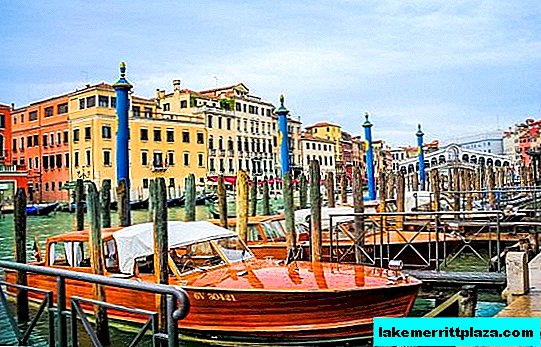Taxis in Venice are not cheap. However, in a city with many canals and islands, taxis are not only the fastest way to get to the right place, but also a great opportunity to add an experience to the trip. Since there is very little information on the Internet about taxi in Venice, BlogoItaliano decided to figure it out on his own.
The most important thing that needs to be said at the beginning is that in Venice itself there are no taxis, except for a relatively small patch near Piazzale Roma and the seaport. All the traditional roads begin and end here, so taxis directly to Venice are boats.
Water taxi in Venice moves around the city in free mode. The only restriction may be the narrowness of small channels (the so-called RII), as well as the closed private moorings of some hotels - the presence or absence of a mooring can be specified when booking the hotel.

On the island part of Venice only water traffic is allowed
If you stayed in one of the hotels without a berth - it is better to know in advance. Otherwise, you will have to walk some distance (although a taxi, by itself, will try to drop you as close as possible to your destination).
You can also use the water taxi service in Venice if you are planning an excursion to the islands of the Lagoon: Murano, Burano and others.
How to find and call a taxi in Venice
It is very difficult to catch a water taxi in Venice on the canals themselves: as a rule, they call it by phone (which adds from 6 to 10 euros to the counter before departure). There are organized taxi moorings. The most famous of them are located at the Rialto Bridge and at St. Mark's Square.

There are organized taxi berths in Venice, but there are very few of them.
Water taxi service is provided by VeniceWaterTaxi, CooperativaTaxiSerenissima, ConsorzioMotoscafiVenezia. For lovers of luxury, there is even the opportunity to order a water limousine.
Tariffs and rules
Calculation of the cost of a water taxi can be carried out according to the rental time - each minute costs about 1.3 euros. At night (22: 00-7: 00) extra charge for the trip will be from 10 to 20 euros. But, usually, there are standard costs along the route:
- Piazzale Roma / Santa Lucia Station - Piazza San Marco - trip through the Canal Grande 90 euros, through small channels 60 euros.
- Piazzale Roma / Santa Lucia Station - Rialto Bridge 50 Euro. Group 1-4 passengers.
The water taxi boat is designed for 10 people. At the same time, for 1-4 passengers, the price is fixed, and for each passenger in excess of the norm, a surcharge of 10 euros is charged.

The cost of a water taxi from the station to Piazza San Marco is 60-90 euros
You should also pay for the carriage of 5 or more pieces of luggage, each additional seat in this case will cost 5 euros (in total, the boat is designed for 12 baggage).
According to Katie, our guide in Venice, in the season from March to November, when traveling to the Lagoon Islands, taxis rarely leave for the price of the route. More often they are taken "at disposal" (rent a taxi boat + driver) at a price of 120 euros per hour for a group of 1-4 people.
Tipping is usually left at a rate of approximately 10% of the amount of the trip, but this, of course, remains at your discretion.
Taxi from airports
As we said above, only the water transport is allowed on the island part of Venice, and the main airports where travelers most often fly are 2. One - Marco Polo - refers to Venice itself; the second - Treviso - to the city of the same name on the mainland.
If you fly to Marco Polothen you have 2 options to choose from. The first is to overcome part of the way - from the airport to Piazzale Roma - by regular taxi, and part - from Piazzale Roma to your hotel - by water. The second way is to completely overcome all the way through the water. The airport has a special pier for taxi boats.

Marco Polo Airport can be reached all the way by water
If you arrive in Treviso, only the first method works here (car + boat), since Treviso is located in the depths of the mainland and there is no water taxi berth.
A regular taxi ride from Marco Polo Airport to Piazzale Roma in Venice will take about 15 minutes and will cost around 40-50 Euros.
A trip from Treviso Airport to Piazzale Roma, due to the greater distance, will cost more - from 60 to 100 euros. The fare is about 1.6 euros per 1 km of track (2 euros for a distance of over 50 km); Plus, you will need to pay extra for landing - 3.2 euros during the day and 6.4 euros at night. Each piece of luggage will also cost an additional 1 Euro.

Some Venetian hotels have their own private berths.
Regardless of the airport, you can also book a car online - at the time of your arrival. In this case, you will know in advance the exact fare of the trip, and you will not have to pay for a simple car at the airport even if the flight is too late - the service monitors the scoreboard on its own and sends the car on time.
A taxi driver ordered online meets passengers in the arrivals hall with a sign indicating their names. You can familiarize yourself with the rates and book a car for arrival on these pages:
- Taxi from Marco Polo Airport (car)
- From Marco Polo Airport (car + boat)
- From Treviso Airport

Taxi fare from Marco Polo Airport to Venice
Finally, there is an official water taxi fare from Marco Polo Airport to San Marco in Venice. It is 120 Euros.
Despite the existence of official prices, in practice taxi drivers in Venice often neglect them and appoint their own. At the same time, taking into account local characteristics, the result of bargaining does not always remain in favor of the passenger.
Photos by: Jeremy Thompson, star5112, pixabay.com, brando, Stephan Kiessling, Pablo Sanxiao.








